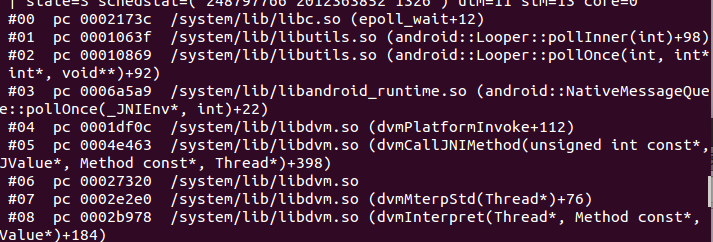本文主要讨论了Android+ARM平台的backtrace原理以及inlineHook中涉及到的多线程安全的问题。
本文关于Arm Inline Hook线程处理的解决方案已经过时,新方案点这里
前言
在之前的Android inline hook项目中,在复杂环境下,如果遇到下面两个场景可能导致异常,甚至引起被hook进程的crash。
- 待hook的函数正在执行;
- 待hook的函数处于函数调用栈中;
举个例子,代码为:1 2 3 4 5 6 7 8 9 10 11 12 13 14 15 16 17 18 19 20 21 22 23 24 25 26 27 28 29 30 31 32 33
| #include <stdio.h> #include <pthread.h> #include "inlineHook.h" int new_thread() { while(1) { printf("new_a\n"); sleep(1); } } int thread() { while(1) { printf("a\n"); sleep(1); } } int main() { int err; pthread_t tid; err = pthread_create(&tid, NULL, thread, NULL); if (err) { return -1; } pthread_join(tid, NULL); return 0; }
|
当我们对要hook的代码前8-10个字节变动的时候,如果子线程刚好执行到此处,或者子线程的函数调用栈包含此处地址,那么有一定几率会导致异常甚至crash。
backtrace
为了防止上述情况发生,我们在hook之前需要对当前进程的所有线程做检测,以确保hook的函数不在当前的函数调用栈中。我们可以利用backtrace机制,获取线程的每层调用地址与我们需要hook的函数地址做比较,来实现该检测。
栈回溯(backtrace)是指程序运行时打印出当前的调用栈,在程序发生崩溃时,系统常常会打印出栈回溯信息。linux+arm平台下,编译器通过unwind实现栈回溯。

上面是在Android平台通过kill -3 pid命令打印出的调用栈,包含了调用的函数、具体偏移地址以及现场保存的寄存器信息。我们只需要其中的每一层的调用具体地址即可。不走运的是,NDK中并没有提供直接backtrace的接口函数,查看源码,在dalvik/vm/interp/Stack.cpp的dvmDumpNativeStack函数实现了backtrace的功能,dvmDumpNativeStack源码如下:
1 2 3 4 5 6 7 8 9 10 11 12 13 14 15 16 17 18 19 20 21 22 23
| void dvmDumpNativeStack(const DebugOutputTarget* target, pid_t tid) { #ifdef HAVE_ANDROID_OS const size_t MAX_DEPTH = 32; backtrace_frame_t backtrace[MAX_DEPTH]; ssize_t frames = unwind_backtrace_thread(tid, backtrace, 0, MAX_DEPTH); if (frames > 0) { backtrace_symbol_t backtrace_symbols[MAX_DEPTH]; get_backtrace_symbols(backtrace, frames, backtrace_symbols); for (size_t i = 0; i < size_t(frames); i++) { char line[MAX_BACKTRACE_LINE_LENGTH]; format_backtrace_line(i, &backtrace[i], &backtrace_symbols[i], line, MAX_BACKTRACE_LINE_LENGTH); dvmPrintDebugMessage(target, " %s\n", line); } free_backtrace_symbols(backtrace_symbols, frames); } else { dvmPrintDebugMessage(target, " (native backtrace unavailable)\n"); } #endif }
|
dvmDumpNativeStack函数功能为打印指定线程的backtrace,这里是直接将打印信息输出,与需求不符。查阅system/core/libcorkscrew/backtrace.c中的unwind_backtrace_thread函数:
1 2 3 4 5 6 7 8 9 10 11 12 13 14 15 16 17 18 19 20 21 22 23 24 25 26 27 28
| ssize_t unwind_backtrace_thread(pid_t tid, backtrace_frame_t* backtrace, size_t ignore_depth, size_t max_depth) { if (tid == gettid()) { return unwind_backtrace(backtrace, ignore_depth + 1, max_depth); } ALOGV("Unwinding thread %d from thread %d.", tid, gettid()); #if defined(CORKSCREW_HAVE_ARCH) && !defined(__APPLE__) struct sigaction act; struct sigaction oact; memset(&act, 0, sizeof(act)); act.sa_sigaction = unwind_backtrace_thread_signal_handler; act.sa_flags = SA_RESTART | SA_SIGINFO | SA_ONSTACK; sigemptyset(&act.sa_mask); pthread_mutex_lock(&g_unwind_signal_mutex); map_info_t* milist = acquire_my_map_info_list(); ssize_t frames = -1; if (!sigaction(SIGURG, &act, &oact)) { g_unwind_signal_state.map_info_list = milist; g_unwind_signal_state.backtrace = backtrace; g_unwind_signal_state.ignore_depth = ignore_depth; g_unwind_signal_state.max_depth = max_depth; ...
|
这里由于函数比较长,只贴出了前部分。其中判断如果线程id为当前线程id,则直接调用unwind_backtrace函数,而unwind_backtrace函数通过调用_Unwind_Backtrace、__Unwind_Backtrace、__gnu_Unwind_Backtrace解析.ARM.extab和.ARM.exidx节(具体解析过程实在有点麻烦,不再深入研究),将每层调用栈的信息存存入类型为backtrace_frame_t的backtrace结构体中,贴出backtrace_frame_t定义:
1 2 3 4 5
| typedef struct { uintptr_t absolute_pc; uintptr_t stack_top; size_t stack_size; } backtrace_frame_t;
|
其中absolute_pc即为调用地址,unwind_backtrace_thread的返回值则为调用栈的层数。
方案
最后给出具体的方案:
- 遍历/proc/pid/task目录,获得进程下的所有线程id号;
- 通过tkill函数向所有线程发SIGSTOP信号;
- 通过dlopen、dlsym调用libcorkscrew.so的unwind_backtrace_thread函数,获得所有线程的函数调用栈信息;
- 遍历所有线程的函数调用栈信息,将每层调用地址与需要hook的函数作判断,若调用地址均不位于待hook的函数内,则可以安全的进行inline hook,否则停止;
- 通过tkill函数向所有线程发生SIGCONT信号;
参考
- Android下打印调试堆栈方法:http://docs.oracle.com/cd/E26926_01/html/E25910/chapter6-43405.html#scrolltoc
- Android4.4.2源码:http://androidxref.com/4.4.4_r1/xref/system/core/include/corkscrew/
